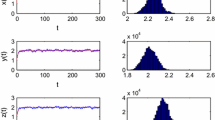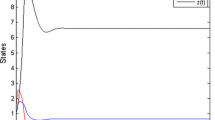Summary
A detailed sensitivity analysis of a model of a predator-prey system comprised ofTetranychus urticae andPhytoseiulus persimilis was performed. The aim was to assess the relative importance of the life history parameters of both species, the functional response, and the components of the numerical response. In addition, the impact of the initial predator-prey ratio and the timing of predator introduction were tested. Results indicated that the most important factors in the system were relative rates of predator and prey development, the time of onset of predator oviposition, and the mode of the predator's oviposition curve. The total oviposition of the predator, the effect of prey consumption on predator oviposition, and predator searching were important under some conditions. Factors of moderate importance were the adult female predator's functional response, total prey oviposition, the mode of the prey's oviposition curve, abiotic mortality of the pre-adult predator, and the effect of prey consumption on predator development and on the immature predator's mortality. Factors of least importance were the variances of the predator's and prey's oviposition curves, the abiotic mortality of the adult predator, the abiotic mortality of the pre-adult and adult prey, the functional response of the nymphal and adult male predators, and the effect of prey consumption on adult predator mortality. The sex ratios had little effect, except when the proportion of female predators was very low. The initial predator-prey ratio and time of predator introduction had significant impacts on system behavior, though the patterns of impact were different.
Similar content being viewed by others
References
Beddington, J. R., M. P. Hassell andJ. H. Lawton (1976) The components of arthropod predation II. The predator rate of increase.J. Anim. Ecol.45: 165–185.
Berryman, A. A. (1978) Towards a theory of insect epidemiology.Res. Popul. Ecol.19: 181–196.
Berryman, A. A. (1982) Biological control, thresholds, and pest outbreaks.Environ. Entomol.11: 544–549.
Bravenboer, L. andG. Dosse (1962)Phytoseiulus riegeliDosse als Prädator einiger Schadmilben aus derTetranychus urticae-Gruppe.Ent. Exp. Appl.5: 291–304.
Caswell H. (1978) A general formula for the sensitivity of population growth rate to changes in life history parameters.Theor. Popul. Biol.14: 215–230.
Caswell, H. andA. Hastings (1980) Fecundity, developmental time, and population growth rate: an analytical solution.Theor. Popul. Biol.17: 71–79.
Cole, L. C. (1954) The population consequences of life history phenomena.Quart. Rev. Biol.29: 103–137. (Reprinted inHazen.)
Croft, B. A., R. L. Tummala, H. Riedl andS. M. Welch (1976) Modeling and management of two prototype apple pest subsystems. 97–119. InR. L. Tummala, D. L. Haynes andB. A. Croft (eds)Modeling for pest management. Michigan States University Press, East Lansing, Michigan.
Fujita, K., T. Inoue andA. Takafuji (1979) Systems analysis of an acarine predator-prey system. I.Res. Popul. Ecol.21: 105–119.
Gould, H. J., N. W. Hussey andW. J. Parr (1969) Large scale commercial control ofTetranychus urticaeKoch on cucumbers by the predatorPhytoseiulus persimilis A-H.Proc. 2nd Int. Cong. Acar. pp. 383–388.
Harmsen, R., M. R. Rose andB. Woodhouse (1976) A general mathematical model for insect outbreak.Proc. Entomol. Soc. Ontario.107: 11–18.
Hassell, M. P., J. H. Lawton andJ. R. Beddington (1977) Sigmoid functional responses by invertebrate predators and parasitoids.J. Anim. Ecol.46: 249–262.
Hazen W. E. (ed) (1970)Readings in population and community ecology, 2nd ed. W. B. Saunders, Philadelphia.
Hoel, P. G. (1971)Introduction to mathematical statistics, 4th ed. John Wiley & Sons, New York.
Hogg, R. V. andA. T. Craig (1972)Introduction to mathematical statistics, 3rd ed. MacMillan, London. Reference fromTaylor (1979).
Holling, C. S. (1959) The components of predation as revealed by a study of small-mammal predation of the European pine sawfly.Can. Entomol.91: 293–320. (Reprinted inHazen 1970).
Huffaker, C. B. andC. E. Kennett (1956) Experimental studies on predation: Predation and cyclamenmite populations on strawberries in California.Hilgardia25: 191–222.
Huffaker, C. B., M. van de Vrie andJ. A. McMurtry (1970) Tetranychid populations and their possible control by predators: an evaluation.Hilgardia40: 391–458.
Hussey, N. W., W. H. Read andJ. J. Hesling (1969)The pests of protected cultivation. Edward Arnold Ltd., London.
Lewontin, R. C. (1965) Selection for colonizing ability. 77–91. InH. G. Baker andG. L. Stebbins (eds)The genetics of colonizing species. Academic Press, New York.
Ludwig, D., D. D. Jones andC. S. Holling (1978) Qualitative analysis of insect outbreak systems: the spruce budworm and forest.J. Anim. Ecol.47: 315–332.
May, R. M. (1977) Thresholds and breakpoints in ecosystems with a multiplicity of stable states.Nature269: 471–477.
McClanahan, R. J. (1968) Influence of temperature on the reproductive potential of two mite predators of the two-spotted spider mite.Can. Entomol.100: 549–556.
Miller, D. R. (1974) Sensitivity analysis and validation of simulation models.J. Theor. Biol.48: 345–360.
Miller, D. R., D. E. Weidhaas andR. C. Hall (1973) Parameter sensitivity in insect population modeling.J. Theor. Biol.42: 263–274.
Murdoch, W. W. andA. Oaten (1975) Predation and population stability.Adv. Ecol. Res.9: 1–131.
Rabbinge, R. (1976)Biological control of fruit-tree red spider mite. Pudoc, Wageningen, the Netherlands.
Rabbinge, R. andM. A. Hoy (1980) A population model for two-spotted spider miteTetranychus urticae and its predatorMetaseiulus occidentalis.Ent. Exp. Appl.28: 64–81.
Readshaw, J. L. andW. R. Cuff (1980) A model ofNicholson's blowfly cycles and its relevance to predation theory.J. Anim. Ecol.49: 1005–1010.
Shaw, P. B. (1985a) A detailed study of the life history ofPhytoseiulus persimilis: developmental rate, age-specific fecundity, survivorship, and sex ratio over a range of temperatures. In Prep.
Shaw, P. B. (1985b) A detailed study of the life history ofTetranychus urticae: developmental rate, age-specific fecundity, survivorship, and sex ratio over a range of temperatures. In prep.
Shaw, P. B. (1984) Simulation model of a predator-prey system comprised ofPhytoseiulus persimilisAthias-Henriot (Acari: Phytoseiidae) andTetranychus urticaeKoch (Acari: Tetranychidae) I. Structure and validation of the model.Res. Popul. Ecol.27: 235–259.
Southwood, T. R. E. andH. N. Comins (1976) A synoptic population model.J. Anim. Ecol.45: 949–965.
Stenseth, C. (1979) Effect of temperature and humidity on the development ofPhytoseiulus persimilis and its ability to regulate populations ofTetranychus urticae (Acarina: Phytoseiidae, Tetranychidae).Entomophaga24: 311–317.
Takafuji, A. andD. A. Chant (1976) Comparative studies of two species of predacious phytoseiid mites (Acarina: Phytoseiidae), with special reference to their responses to the density of their prey.Res. Popul. Ecol.17: 255–310.
Takahashi, F. (1964) Reproduction curve with two equilibrium points: a consideration on the fluctuation of insect population.Res. Popul. Ecol.6: 28–36.
Taylor, F. (1979) Convergence to the stable age distribution in populations of insects.Am. Nat.113: 511–530.
Vithayathil, F. J. andH. A. Hirsh (1975) Sensitivity analysis of a simulation model of an agricultural ecosystem—some preliminary results.Modeling and Simulation6: 837–842.
Wollkind, D. J., A. Hastings andJ. A. Logan (1980) Functional response, numerical response, and stability in arthropod predator-prey systems involving age-structure.Res. Popul. Ecol.22: 323–338.
Author information
Authors and Affiliations
Rights and permissions
About this article
Cite this article
Shaw, P.B. Simulation model of a predator-prey system comprised ofPhytoseiulus persimilis andTetranychus urticae. II. Model sensitivity to variations in the life history parameters of both species and to variations in the functional response and components of the numerical response. Res Popul Ecol 27, 1–23 (1985). https://doi.org/10.1007/BF02515476
Issue Date:
DOI: https://doi.org/10.1007/BF02515476




